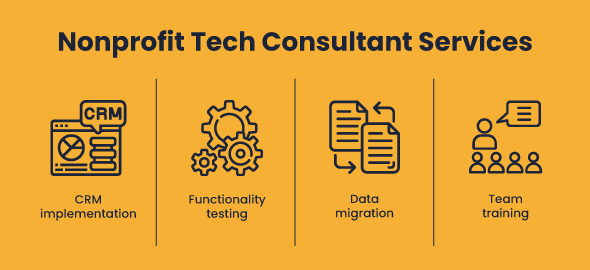How to Move from Spreadsheets to Advanced Nonprofit Tech
When you first start a nonprofit, constituent relationship management (CRM) software likely isn’t your top priority. You’ve got tax forms to file, donors to find, and countless other important steps to take to get your new organization up and running. At the time, using spreadsheets to keep track of data is the simplest solution at your disposal. Once your nonprofit starts to grow, however, you may run into issues.
Spreadsheets can only do so much for a growing nonprofit with hundreds or thousands of supporters to keep track of. Moving to an advanced, scalable CRM allows you to easily house, organize, and analyze all of your data in one place—leading to better insights and more efficient staff.
If you’re ready to move to a system that will increase your organization’s capacity to further its mission, we’ll cover four steps you can take:
- Evaluate Your Budget and Choose a CRM
- Partner with a Nonprofit Tech Consultant
- Organize Your Data for Migration
- Train Your Team to Use the New System
Switching to any new technology can feel daunting, especially when there’s valuable data involved. Let’s walk through what you can do to feel prepared for the change.
1. Evaluate Your Budget and Choose a CRM
First, determine your organization’s budget for a CRM. This will require input from your board and leadership team, so be sure to loop them in early on in the process. As you create your budget, don’t forget to account for additional costs beyond the sticker price of the software itself, such as user licenses, consulting services, and implementation costs.
With a clear budget in mind, you can start researching the top fundraising CRMs to find the best fit for your organization. Evaluate options based on factors like:
- Scalability. How much data can you store in the CRM? Will it be able to easily scale with your nonprofit’s needs?
- Nonprofit-specific features. Choosing a system that was designed with nonprofits’ needs and goals in mind will provide you with all the most relevant, useful features.
- Ease of use. If you don’t have tech experts on your team, choosing an intuitive platform that doesn’t require too much customization or training is key.
- Availability of add-ons and integrations. Do you already have an event platform or marketing automation tool that you use? Check to see if they can integrate with the CRM.
Once you have a shortlist of options, schedule product demos and discuss the pros and cons of each CRM with your team. If you find that you don’t have enough room in your budget to invest in your top choice, Getting Attention suggests seeking out a technology grant from a corporation or foundation to cover some of the costs.
2. Partner with a Nonprofit Tech Consultant
Next, partner with a nonprofit technology consultant who can guide you through the remainder of the implementation and migration processes.
Ideally, you should find a partner who has experience with the CRM you chose in the former step. For example, if you’re interested in moving to Salesforce for Nonprofits, look for an expert who offers specialized Salesforce nonprofit consulting services. That way, they can educate you on exactly how your data needs to be formatted for the move and help you strategically leverage the platform of your choice.
Beyond that, Redpath’s nonprofit CRM implementation guide explains that the right partner can help your organization with every aspect of the process, including:

- CRM implementation
- Functionality testing and fixes
- Data migration
- Team training
While guiding you through the implementation process, a qualified consultant can also look at your current data management practices and explain how to use your new system to improve them.
3. Organize Your Data for Migration
The only way to successfully migrate your data from spreadsheets to a CRM is to ensure that your data is formatted consistently and correctly for the new system.
Spreadsheets can be haphazard and disorganized, with different team members inputting information in different ways. Where one person might only add “yes” or “no” in a column tracking conversations with donor prospects, for example, someone else may leave long comments about what they discussed in each conversation.
Your consultant should be able to help you understand exactly how your data needs to be formatted for the specific CRM you’re implementing, including which fields need to match up and how to verify that everything is organized correctly. But before you reformat your data, it’s your responsibility to ensure that it’s clean and up to date.
Clean up your data now by going through your spreadsheets and removing or updating:
- Outdated information like old phone numbers, email addresses, or mail addresses.
- Duplicate data, where the exact same information appears in multiple places.
- Any information you used to collect but no longer use, such as participant information for a program that ended years ago.
From here, your consultant can make a detailed data migration plan for moving all of the data you’ve identified to your new system and mitigating the risk of data loss. They’ll perform the migration and let you know what your role is in the process.
4. Train Your Team to Use the New System
Finally, work with your consultant to find the best training resources, then schedule training for relevant team members to learn the ropes of your new CRM.
Since you’re moving to an entirely new, more advanced system to house your data, the training process will understandably take time. Be sure to communicate openly with your team throughout implementation and training, and provide them with any additional support they may need to navigate this change.
While you’re devoting time to training, this is also a good time to implement some new policies based on data hygiene best practices to ensure your data stays accurate and usable going forward. This might include adding rules that standardize how team members input data and handle issues that arise. For example, clarify that addresses should always use abbreviations like “St.” and “Ave.” rather than spelling them out.
With a new, advanced CRM at your fingertips, your nonprofit’s team will be better equipped to use fundraising, marketing, and donor data to raise more for your mission. As you start using your new platform, note any features or data analysis strategies that prove especially valuable so your team can keep improving.



